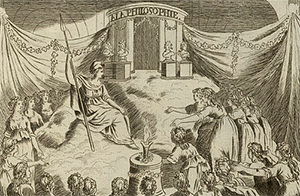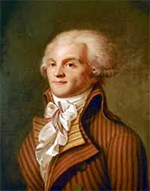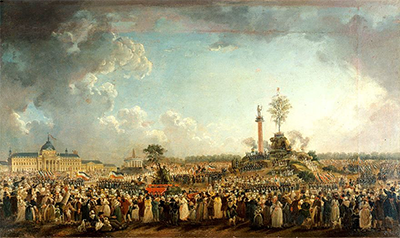The Cult of the Supreme Being
The Cult of the Supreme Being was a new religion invented by republican leaders of the French Revolution as a substitute for Catholicism. Once the Republic was declared in 1792, the leaders of that Republic announced the formation of the Cult of Reason, intended to a state-sponsored form of atheism, focused not on deities but on liberty, truth, and reason. The philosophe Antoine-François Momoro was an outspoken proponent of this civic religion, as were the Hébertists, followers of Revolution leader Jacques Hébert, and the sans-culottes, the Third Estate muscle behind some of the Revolution's most famous acts. One official who took the anti-Catholic creed to an extreme was Joseph Fouché, the Minister of Police, who ordered crosses and statues removed from graveyards. 
Hébert and Momoro held court at a Fête de la Raison ("Festival of Reason") on Nov. 11, 1793. At churches across the country, including the iconic Notre-Dame Cathedral, Cult of Reason adherents dismantled Christian elements on altars and elsewhere and replaced them with altars to Liberty. Women wearing clothes from ancient Roman times huddled around another woman dressed as the Goddess of Reason; Momoro's wife, Sophie, played this part in Paris. Above the doors at Notre-Dame was carved "To Philosophy." 
One of the prime critics of the Cult of Reason was Maximilien Robespierre (right), who replaced the Cult of Reason with his own Catholicism substitute the Cult of the Supreme Being, in 1794. Robespierre didn't like Catholicism one bit, but he didn't much like atheism, either. He believed in a supreme being, and he wanted his nation to have a religion that worshiped one. He convinced the National Convention to declare it the state civic religion on May 7, 1794. As envisioned by Robespierre, the Cult of the Supreme Being decreed belief in a god to which people would commit words and actions of rational devotion. He envisioned a higher moral code that governed people's actions and encouraged them to cherish democracy and liberty above all. 
The height of the popularity of this new religion was the Festival of the Supreme Being, which took place on June 8, 1794. As with the Festival of Reason, this festival was intended to be nationwide. The largest celebration was, of course, in Paris. The artist Jacques-Louis David designed the festival, and Robespierre served as the lead celebrant. Robespierre and others on the Committee of Public Safety used the status of the Cult of the Supreme Being as the country's civic religion to target some of his political enemies, including Cult of Reason adherents Momoro and Hébert (who was also targeted for other reasons). The death of Robespierre on July 28, 1794, resulted in the unofficial death of the Cult of the Supreme Being. A law announced by Napoleon Bonaparte on April 8, 1802, officially banned the cult. He had, a year earlier, reinstated Catholicism as France's state religion.
|
|
Social Studies for Kids
copyright 2002–2025
David White




